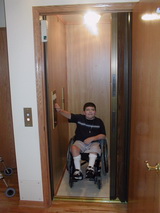Hydraulic Elevators
For many years, there were two basic types of elevators, hydraulic and cable lifted elevators. However, one of the benefits of hydraulic elevators that made them preferable back then and preferable still today is the fact that they are capable of carrying great amounts of weight. Unfortunately, there are some disadvantages as well. Whether in a commercial or residential building, hydraulic elevators require a pit beneath the elevator because they are driven from below.
How Hydraulic Elevators Work
To put it simply, hydraulic elevators work by a piston that pushes the elevator car up when fluid pressure is forced into a cylinder that contains the piston. As fluid is forced into that cylinder, the piston is forced upwards which in turn causes the elevator to rise. The fluid is drawn from a reservoir which will also collect the fluid again as the elevator descends. By releasing the fluid at a controlled rate, the piston is allowed to fall back down the cylinder at a controlled rate while the fluid is returned to the reservoir. Although simplistic, those are the mechanics that operate hydraulic elevators.
Some Pros and Cons of Hydraulic Elevators
As mentioned, hydraulic elevators can handle a great deal of weight because of the support from the cylinder below the unit. They can easily be oversized because of this capacity; but size is also a major drawback. The machinery itself that drives the elevator is also quite bulky and needs to be installed below the elevator. For this reason, it is virtually impossible to install hydraulic elevators in existing structures. Expense is another issue altogether. Since the entire length of the cylinder needs to be below ground level, the builder would need to dig deep enough to accommodate the shaft. As a result, for extremely tall buildings, the cylinder would need to be that distance below ground. So if you were building a structure that is 20 stories high, you would need to dig at least 19 stories deep!
Stabilizing Hydraulic Elevators
There are various methods employed for stabilizing hydraulic elevators. Some types use a multi-piston mechanism while others are stabilized (balanced) by cables suspended from above. However, most if not all hydraulic elevators are installed on a track that also provides balance to the cab. For example, if ten people enter the elevator and nine of them stand to the left while only one person walks to the right, you would need to balance the car so that it didn't tip to the left. Stabilizing hydraulic elevators is also costly, but is one of the most necessary components.
Although it would be highly impractical, if not impossible, to add a hydraulic elevator to an existing building, there are times when this type of elevator is the best choice. When the elevator is going to be required to handle heavy loads, this type of mechanism is one of the safest and most functional. There are a number of companies that can provide quotes and prices may vary from company to company. However, since these are heavy duty elevators most of the time, price should never be a consideration. Safety is always of utmost importance.

